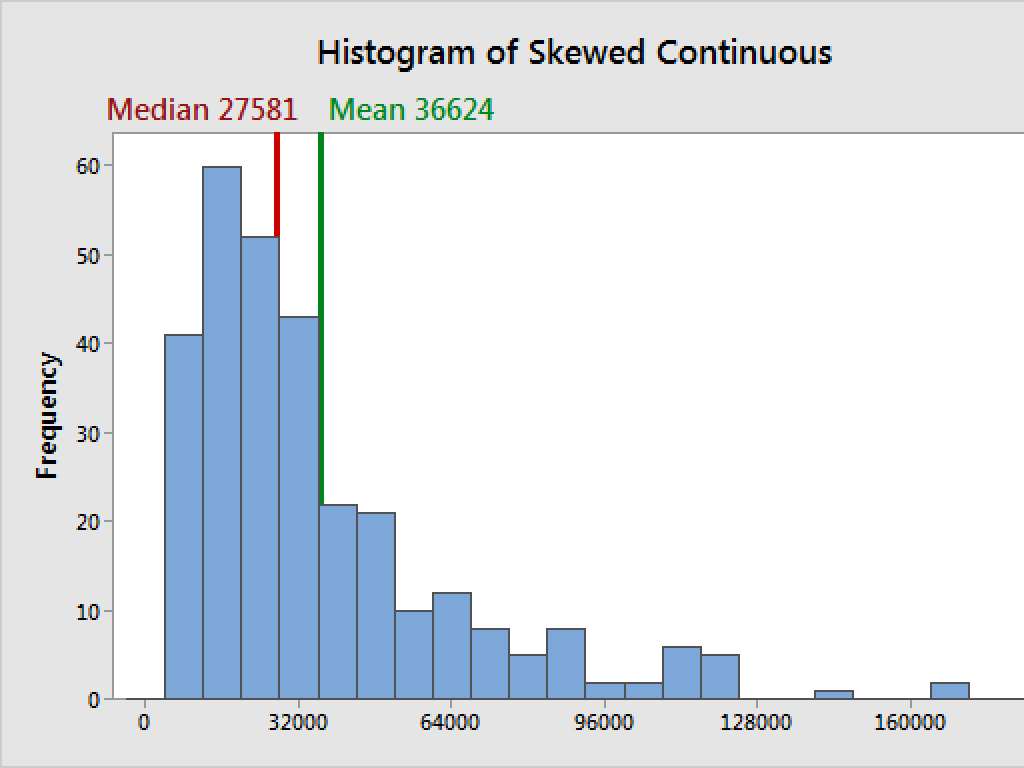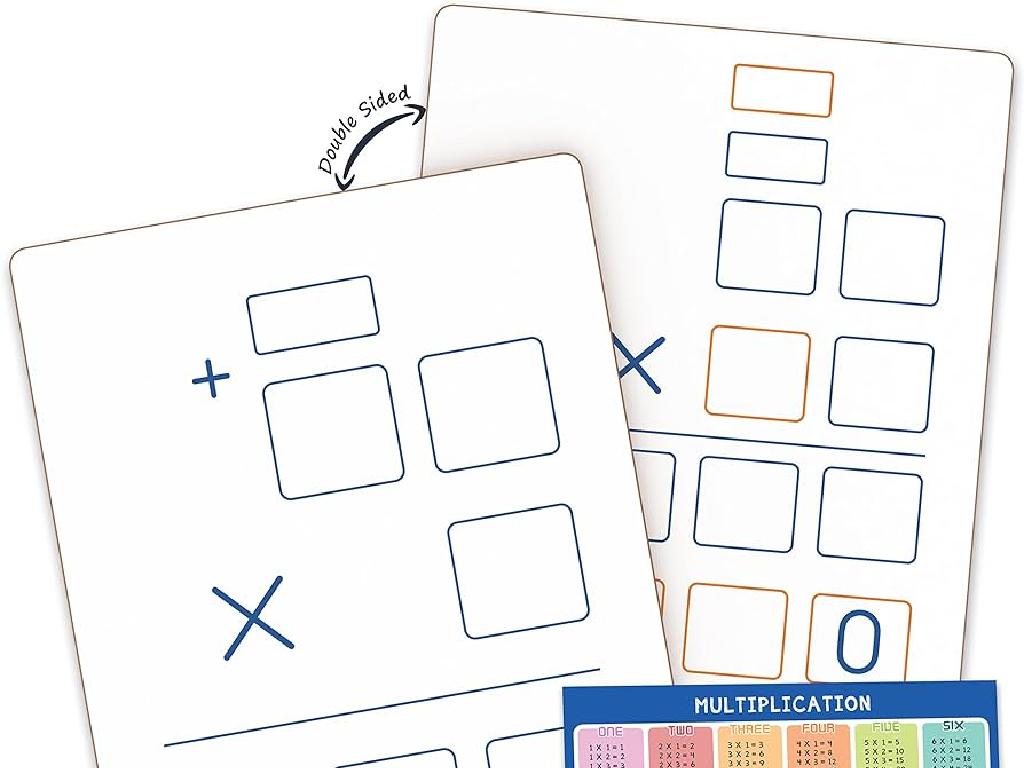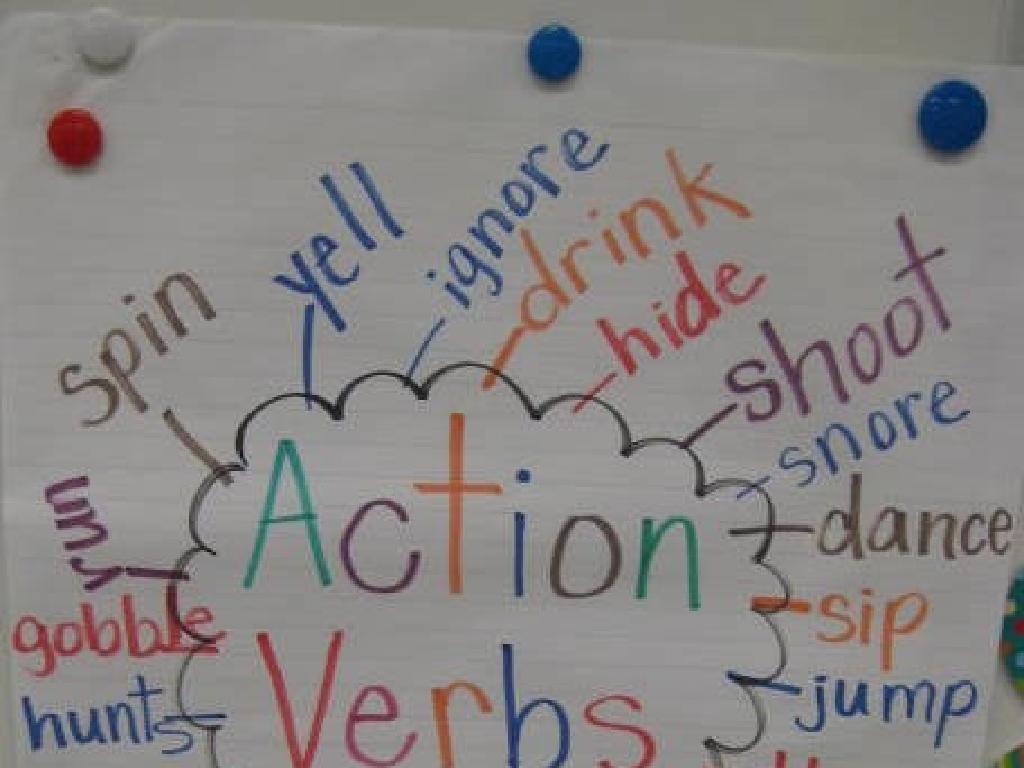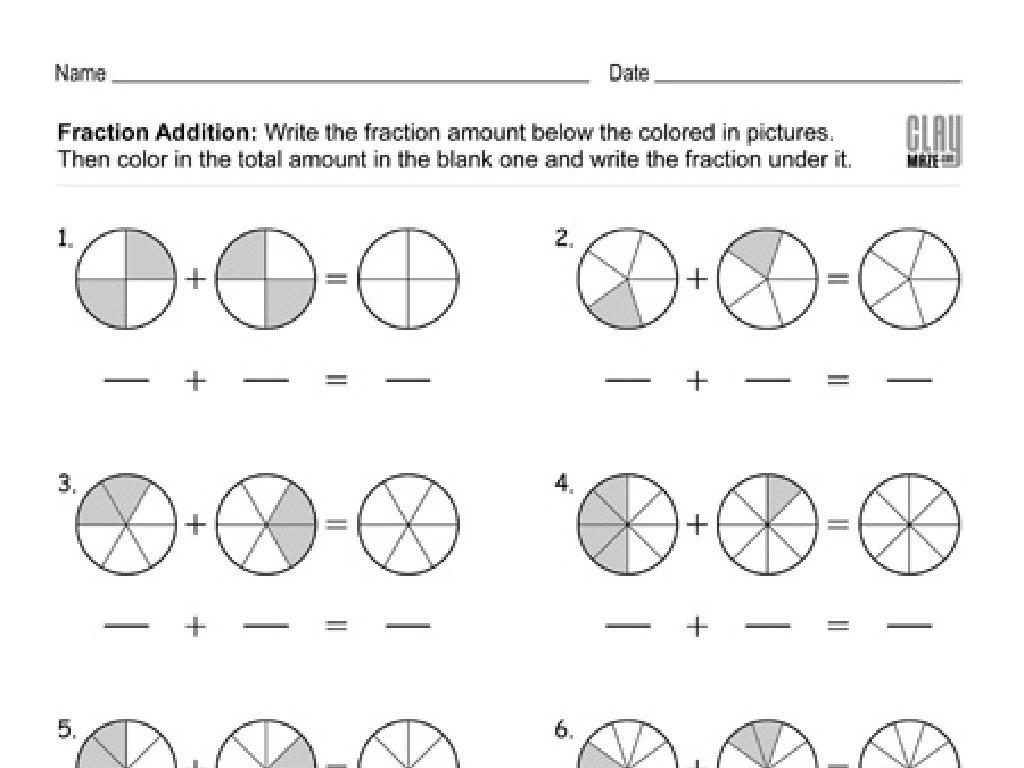Add, Subtract, Multiply, Or Divide Two Integers
Subject: Math
Grade: Sixth grade
Topic: Operations With Integers
Please LOG IN to download the presentation. Access is available to registered users only.
View More Content
Welcome to Operations with Integers!
– Understanding integers
– Integers include whole numbers and their negatives
– Exploring operations
– Operations are mathematical processes like +, -, x, ÷
– Today’s focus: 4 basic operations
– We’ll learn to add (+), subtract (-), multiply (x), and divide (÷) integers
– Applying operations to integers
– Use operations to solve integer problems
|
This slide introduces the fundamental concept of integers and the four basic operations in mathematics: addition, subtraction, multiplication, and division. Begin by explaining that integers are not just positive numbers, but also include zero and negative numbers. Clarify that operations are the actions we perform with numbers. Today’s lesson will focus on how these operations work specifically with integers. Provide examples for each operation, such as -3 + 2 for addition, 5 – (-2) for subtraction, -4 x 3 for multiplication, and -12 ÷ -3 for division. Emphasize that understanding these operations with integers is crucial for solving a wide range of math problems. Encourage students to think of real-life situations where they might need to use these operations with integers.
Understanding Integers
– Define integers
– Integers include whole numbers and their negatives
– Positive vs. Negative numbers
– Positive numbers are above zero, negative are below
– Real-life integer examples
– Temperatures, bank balances, elevations
– Integers in math operations
– Adding, subtracting, multiplying, dividing integers
|
Integers are the set of whole numbers and their opposites, including zero. It’s crucial for students to differentiate between positive and negative numbers, as this understanding is foundational for all operations with integers. Provide real-life contexts where integers are used, such as temperatures (above/below freezing), bank account balances (deposits/withdrawals), or elevations (above/below sea level). Emphasize that integers are not just numbers on a paper; they represent real quantities and changes in everyday life. Encourage students to think of additional examples. Finally, explain how these numbers are used in basic math operations, setting the stage for more complex arithmetic involving integers.
Adding Integers
– Rules for adding integers
– Same signs add and keep, different signs subtract
– Use a number line for addition
– Visualize adding positive or negative steps
– Example: 5 + (-3)
– 5 + (-3) equals 2; move 3 steps left from 5
– Practice with different integers
|
When adding integers, students should remember the key rule: if the signs are the same, add the numbers and keep the sign. If the signs are different, subtract the smaller number from the larger and keep the sign of the larger number. Using a number line can help visualize this process, as adding a positive integer means moving to the right, while adding a negative integer means moving to the left. The example 5 + (-3) demonstrates this by starting at 5 on the number line and moving 3 places to the left, resulting in 2. Encourage students to practice with various integers to solidify their understanding. Provide additional examples and have students come up to the board to demonstrate their ability to add integers using a number line.
Subtracting Integers
– Rules for subtracting integers
– To subtract, change to addition and add the opposite integer
– Subtraction as adding a negative
– Think of subtraction as adding the opposite: -2 – 7 is the same as -2 + (-7)
– Example: Subtracting -2 and 7
– -2 – 7 becomes -2 + (-7) = -9
|
When teaching subtraction of integers, start by explaining the rules: to subtract an integer, you add its opposite. Emphasize that subtraction can be thought of as adding a negative number. Use the example -2 – 7 to illustrate this concept. Show that -2 – 7 is the same as -2 + (-7), and then add the integers as usual. This approach helps students understand the relationship between addition and subtraction in the context of negative numbers. Encourage students to practice with various examples and to use number lines if necessary to visualize the process. This will solidify their understanding and prepare them for more complex operations with integers.
Multiplying Integers
– Rules for multiplying integers
– Multiply numbers normally, then apply sign rules
– Determining the answer’s sign
– If signs are the same, the answer is positive; if different, the answer is negative
– Example: Multiplying -4 and 6
– -4 x 6 gives -24 because a negative times a positive is negative
|
When teaching multiplication of integers, start by reinforcing the multiplication of numbers without considering the signs. Then introduce the rules for determining the sign of the product: if the signs of the two numbers are the same, the result is positive; if the signs are different, the result is negative. Use the example -4 x 6 to illustrate this concept. -4 (negative) times 6 (positive) results in -24 because a negative times a positive yields a negative result. Encourage students to practice with additional examples and to remember the rules for signs to build confidence in multiplying integers.
Dividing Integers
– Rules for dividing integers
– Same signs divide to a positive, different signs to a negative
– Division relates to multiplication
– Division is the inverse of multiplication
– Example: -12 ÷ 3
– -12 ÷ 3 equals -4 because -4 times 3 equals -12
– Practice with different signs
|
When teaching division of integers, start by explaining the rules: two integers with the same sign result in a positive quotient, while integers with different signs result in a negative quotient. Emphasize that division is essentially finding the number that, when multiplied by the divisor, equals the dividend. Use -12 ÷ 3 as an example to show that -4 is the correct answer because -4 multiplied by 3 gives -12. Encourage students to practice with various integer combinations to solidify their understanding. Provide additional examples and have students explain the reasoning behind their answers to reinforce the concept.
Practice Problems: Mastering Integer Operations
– Let’s solve addition problems
– Example: 7 + (-3) = ?
– Now, practice subtraction
– Example: (-5) – 2 = ?
– Time for multiplication
– Example: (-4) x 3 = ?
– Finally, let’s divide integers
– Example: 12 ÷ (-3) = ?
|
This slide is designed to engage students in active practice of integer operations. Start with addition and subtraction, ensuring students understand how to combine positive and negative numbers. Use number lines if necessary to visualize the process. Then, move on to multiplication and division, emphasizing the rules for multiplying and dividing positive and negative numbers. Encourage students to work through the examples provided and come up with similar problems on their own. During the class, walk through each type of problem step by step, and then allow students to attempt similar problems independently or in small groups for practice.
Class Activity: Integer Operations Relay
– Teams solve integer problems
– One step per team member
– Pass to the next after solving
– First team with correct answers wins!
|
This activity is designed to encourage collaboration and quick thinking as students work together to solve integer operation problems. Divide the class into small teams, and provide each team with a set of problems involving addition, subtraction, multiplication, and division of integers. Each team member is responsible for one operation and must pass the problem to the next person after completing their step. The first team to finish all problems correctly wins a small prize. This will help students practice their integer operations in a fun and competitive way. Possible variations of the activity could include a relay race where students physically move to a station to complete their step, or a ‘telephone’ game where each student whispers their answer to the next, emphasizing the importance of accuracy in each step.
Wrapping Up: Mastering Integer Operations
– Recap of integer operations
– Why mastering integers matters
Integer operations are foundational for higher math.
– Homework: Integer worksheet
Complete the provided worksheet to practice.
– Practice makes perfect
Keep practicing to improve your skills.
|
As we conclude today’s lesson on integer operations, it’s crucial to emphasize the importance of understanding how to add, subtract, multiply, and divide integers. These skills are the building blocks for algebra and more advanced math topics. For homework, students are assigned a worksheet that covers a variety of integer operation problems to reinforce their learning. Encourage students to attempt every problem and remind them that practice is essential for mastery. During the next class, we will review the worksheet answers and clarify any difficulties the students encountered.





